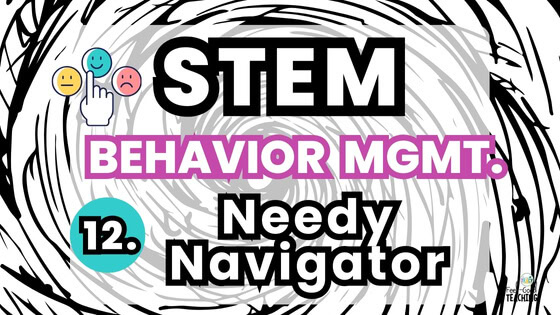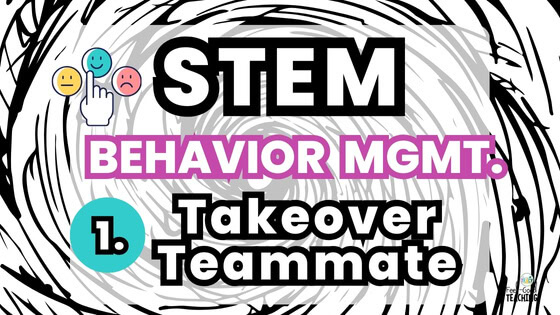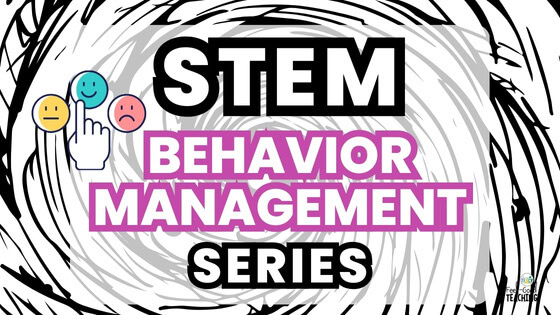Welcome back to the STEM Classroom Management Blog Series! If you missed the first series, check out strategies for more visible behavior challenges like dominant teammates, total disengagement, and destructive disruptors.
For the last few posts, we’ve been exploring more subtle, internal behavior patterns that still get in the way of creative collaboration and meaningful STEM learning.
Today, we’re looking at a tricky one:
Meet the Needy Navigator
This student might:
- Ask you (or peers) for help every few minutes
- Avoid making independent decisions
- Get stuck waiting for approval before taking action
- Panic or shut down without reassurance
They may even appear helpless at times despite being perfectly capable.
It’s not about laziness. In fact, many Needy Navigators care deeply about “doing it right.” But they struggle to take initiative, trust their own thinking, or make mistakes without fear.
Over time, this behavior can:
- Slow group progress
- Disrupt your ability to support other students
- Lead to group resentment or uneven workload
Let’s talk about how to support this student while helping them build independence.
Why It Matters
STEM challenges require risk-taking, decision-making, and problem-solving … all things that feel scary to a Needy Navigator.
But that’s exactly why these challenges are so good for them.
Our goal isn’t to make them struggle but to scaffold their growth. Because when students learn to work through uncertainty, they become more confident, creative thinkers.
What to Do Before, During & After a STEM Challenge
Here’s how to support students before, during, and after a challenge.
🧩 Before the Challenge: Set the Stage for Independence
1. Preview the goal and the unknowns
Let students know upfront:
“This challenge has lots of possible answers. I won’t give you suggestions, because your job is to try to find a solution that works, or learn from attempts that don’t work.”
2. Normalize decision-making struggles Say:
“You might feel unsure. That’s part of the process. We’re here to try, learn, and adjust, not to be perfect.”
3. Assign independence-building roles
Consider making this student the team’s Lead Tester or Materials Manager. Give them a task with clear expectations that requires them to take action.
4. Offer pre-approved prompts
Give students a list of phrases they can use instead of asking for help:
“I’m going to try this and see what happens.”
“I can test it first, then decide.”
“What do you think we should do?” (to teammates)
5. Set ‘ask check-ins’
Say: “You’ll have 5 minutes to work without asking for help. At minute 6, I’ll come check in with you.” This gives them a boundary and a safety net.
🛠️ During the Challenge: Encourage, Don’t Enable
1. Use redirection questions
Instead of answering directly, ask:
“What have you tried so far?”
“What’s one idea you could test first?”
“What do your teammates think?”
2. Praise attempts, not results
When they take initiative, celebrate it! Say: “I love how you tested that on your own first.”
3. Resist the urge to rescue
If their design fails or looks awkward, let it. Then guide reflection instead of swooping in. That’s where the growth happens.
4. Use visible reflection tools
Let students track what they tried and what they learned. This builds confidence and ownership.
5. Keep expectations consistent
If they’re in a group, reinforce:
“We expect everyone to contribute ideas, even rough ones.”
📘 After the Challenge: Reflect on Growth
1. Ask what they figured out on their own
Prompt: “What did you do today that you weren’t sure you could do?”
2. Have the group highlight strengths
Let teammates name how the student contributed. This builds internal evidence of competence.
3. Chart next steps
Ask: “What’s something you want to try without help next time?”
4. Share your observations
“You trusted your own idea and tested it — that’s huge!”
5. Celebrate effort and progress
Growth takes time. Acknowledge every step.
6. Use rubrics that encourage progress in the behaviors you want to reinforce and process over product
Make sure your assessments don’t undermine what you’re actually trying to get students to do! (Scroll down to see my rubrics)
🧠 Final Thought: Empowerment Over Answers
Your Needy Navigator isn’t trying to drive you nuts. They’re doing what’s safest for their nervous system.
But when you support small risks, and celebrate small wins, you’re giving them something more powerful than help.
You’re giving them confidence.
And that will carry far beyond STEM.
You’ve got this. 🧡
💡 Want a Free STEM Classroom Management Handbook?
I’m putting together a printable copy of these strategies as well as navigating other tricky STEM behaviors perfect for keeping in your lesson planner or sharing at your next PLC or team meeting. It will be sent to every subscriber on my email list when the series is complete. Sign up below to get on the list.
Looking for More In-Depth Tips?
STEM Rubrics and Post-Build Routines:
✨ That’s a Wrap!
That’s a wrap on the STEM Classroom Management series … at least for now. Got a tricky student behavior you’d love to see covered in a future post? Use the contact form to let me know. I can always add more down the line.
Explore all posts in the STEM Classroom Management Series here.
Pin it. Share it. Save it. You never know when you’ll need just the right strategy for just the right kid.









